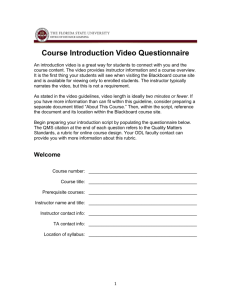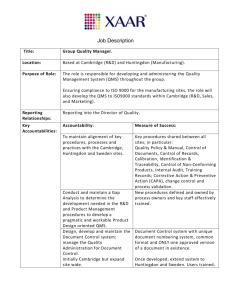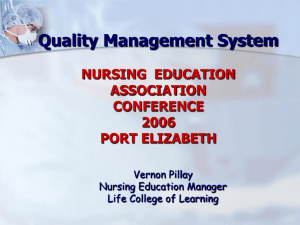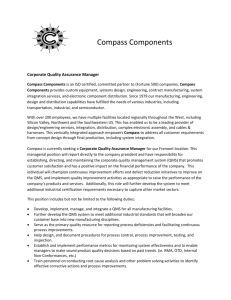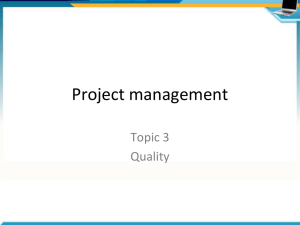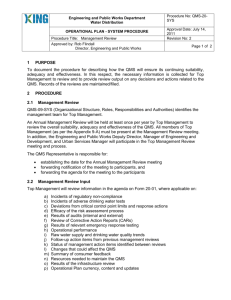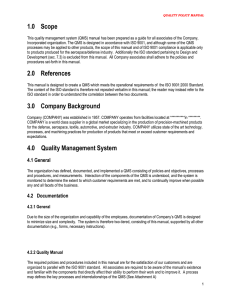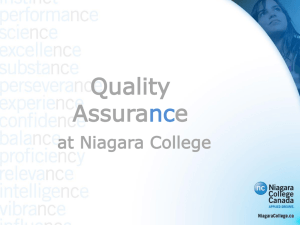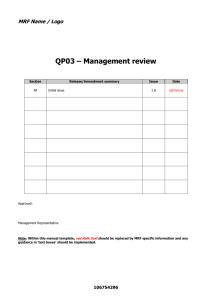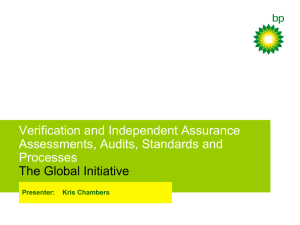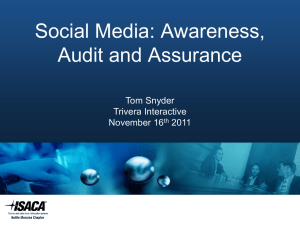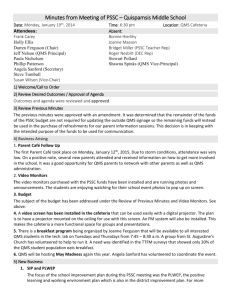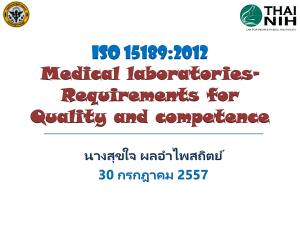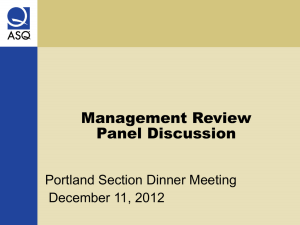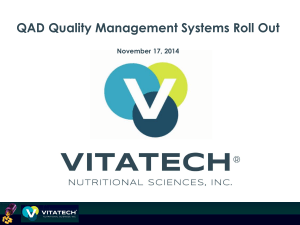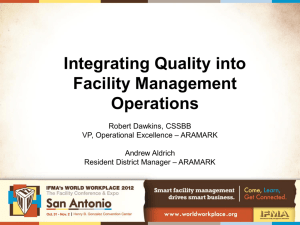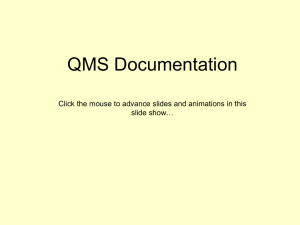Quality Assurance for Local Health Departments
advertisement
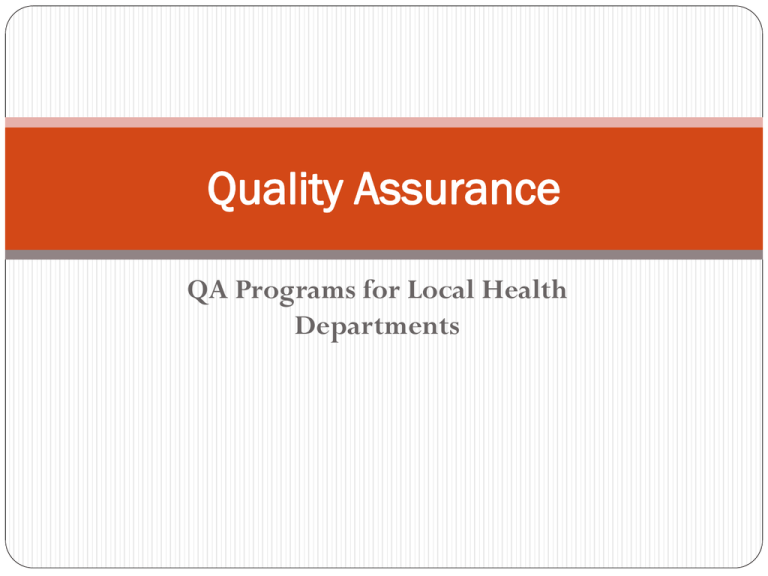
Quality Assurance QA Programs for Local Health Departments Objectives of this course are: Define Quality Know 6 Main Causes of Poor Quality Know 6 Service Quality Dimensions Know Characteristics of a Quality Assurance (QA) Program Explain Purpose of QA Programs in Health Departments Know 8 Developmental Steps of QA Programs Explain Importance of Management “Buy-In” Know S.M.A.R.T. System for Defining Quality Objectives Know 6 Mandatory Procedures for QA Programs What is Quality? Quality has many different definitions Definitions range from informal to formal Some informal definitions are: Excellence Adding Value Commitment to Improve A formal definition is: “Quality is the ongoing process of building & sustaining relationships by assessing, anticipating, & fulfilling stated & implied need.” Why quality? Increase Productivity Reduce Costs, Rework, Delays, & Improve Errors Quality Improve Customer Satisfaction Success in Business 6 Main Causes of Poor Quality Man - Lack of motivation, training, skills, interest Machine - Lack of capability, maintenance, outdated Material Low grade, unspecified, variation Management - Lack of vision, mission, decision making & communication Method - Lack of procedures, communication, procedures not followed Mother nature Humidity, temperature, lighting Further Defining of Quality Many definitions are based on different points of view: From a Process point of view - Conformance with process standards & specifications From a Product point of view – Degree of excellence at an acceptable price From a Cost point of view – Best combination between costs & features From a Customer point of view - Service &/or product meeting customer needs Fitness for Use = does it do what it is suppose to do? Health Departments Focus on Services & Customer Satisfaction Customer satisfaction is an important part of running a successful business. 4 Tips for avoiding customer dissatisfaction are: Be Pro-active Be Responsive Be Honest Be Realistic 6 Service Quality Dimensions Timeliness Courtesy Consistency Convenience Completeness Accuracy These dimensions if implemented wisely will limit customer dissatisfaction. What is Quality Assurance? Quality Assurance (QA) is prevention of quality problems through planned and systematic activities including documentation. Defining QA Programs A Quality Assurance program is a complete system to assure the quality of services &/or products by evaluating performance &/or a service against a standard or specified requirement for customers. It is a way of management. Quality Management System (QMS) Quality Management System (QMS) = QA Program QMS & QA Program is a formalized system that documents the structure, responsibilities, & procedures required to achieve effective quality management. Characteristics of a QA Program Process Driven Pro-Active Staff Functions Prevent Problems & Defects Quality Audit Defining Process Selection of Tools Trainings QA Programs in Health Departments Should strive to promote & protect the health, safety, and well-being of the people being served by providing responsive, independent assessment, and monitoring of human services through respectful relationships. Or as defined by NC Local Health Department Accreditation, Essential Service #9: Local Health Department’s (LHD) shall employ a quality assurance & improvement process to assess the effectiveness of services & improve health outcomes. QA Programs in Health Care Assist with: Monitoring & ensuring that mandatory standards & protocols are being met; Identifying areas needing improvement; Implementing performance improvement plans; And, making sure regulations are clearly interpreted & followed. QA Programs have 8 Main Development Steps Learn Plan Define Build Launch Review Assess Improve Step #1: Learn **Top Management Buy-In** Define Scope Conduct Gap Analysis Management Review **Lack of top management commitment will cause failure or loss of organizational productivity, profitability, effective work-place efficiency, job satisfaction, employee morale, & continuous product/service improvement** Importance of Management Buy-In Management needs to provide evidence of their commitment to QMS by: Communicating importance of meeting customer & legal requirements; Setting up quality policy & quality objectives; Conducting regular management reviews; & ensuring that required resources are made available. Step #2: Plan Establish an Implementation Team Develop Implementation Plan Identify Key Processes Involve & Communicate with Employees Management Review Step #3: Define Define the Quality Policy Communicate the Quality Policy **Define the Quality Objectives** Establish Roles & Responsibilities Management Review Defining Quality Objectives Quality Objectives are S.M.A.R.T S – it must be Specific M – it must be Measurable A – it must be Achievable R – it must be Realistic T – it must be Time Bound Quality Objectives should be set aiming to improve the effectiveness of the QMS Step #4: Build Develop the Quality Manual **Develop the Mandatory Procedures** Including Operational Procedures & Auditing Tools Each compliance point should match with a performance standard to serve as benchmarks in audits. Select & Train Internal Auditors Management Review 6 Mandatory Procedures Control of Documents Control of Records Internal Audit Control of Non-Conforming Product Corrective Action Preventative Action Step #5: Launch Provide Employee System Training Implement the Quality System Audit the Quality System Management Review Step #6: Review Begin Process Auditing Implement System Changes Refine the System Management Review Step #7: Assess Pre-Assessment Audit Correct Non-Conformances & Corrective Actions Management Review Step #8: Improve Maintain & Improve the QMS Developing a QMS Generally takes from 1-9 months depending; On Business Size & Type; How many Protocols & Procedures are documented; How many & what Type of Records are kept; Management commitment; & Resources FDA Voluntary Retail Standards: Compliance Tool for Standard 4 1) Determines & documents the compliance status of each risk factor & intervention through observation & investigation: (i.e., IN compliance, OUT of compliance, Not Observed [NO,] or Not Applicable [NA] is noted on inspection form); 2) Completes an inspection report that is clear, legible, concise, & accurately records findings & observations; 3) Interprets & applies laws, regulations, policies & procedures correctly; 4) Cites the proper local code provisions for CDC-identified risk factors & Food Code interventions; 5) Reviews past inspection findings & acts on repeated or unresolved violations; 6) Follows through with compliance & enforcement actions; 7) Obtains on-site corrective action; 8) Discusses & documents discussion of options for implementing food safety systems, when required; 9) Confirms that the facility is assigned to the correct risk category & inspection frequency; & 10) Files reports and other documentation in a timely manner. Conclusion Quality Management Systems, or Quality Assurance Programs ensure an organization is doing due diligence to maintain compliance, while improving customer service and satisfaction. References NC Institute for PH. “NC LHD Accreditation, Health Department Self Assessment Instrument” retrieved 2/21/2013 from http://nciph.sph.unc.edu/accred/health_depts/materials/index.htm “ISO 9000:2005 Quality Management Systems – Fundamentals & Vocabulary” “ISO 9001:2008 Requirement” retrieved 2/21/2013 from http://www.qualitygurus.com “Quality Assurance Division Mission” retrieved 2/21/2013 from http://budget.mt.gov/content/execbudgets/2013_Budget/2013B_Docs/6901.pdf

